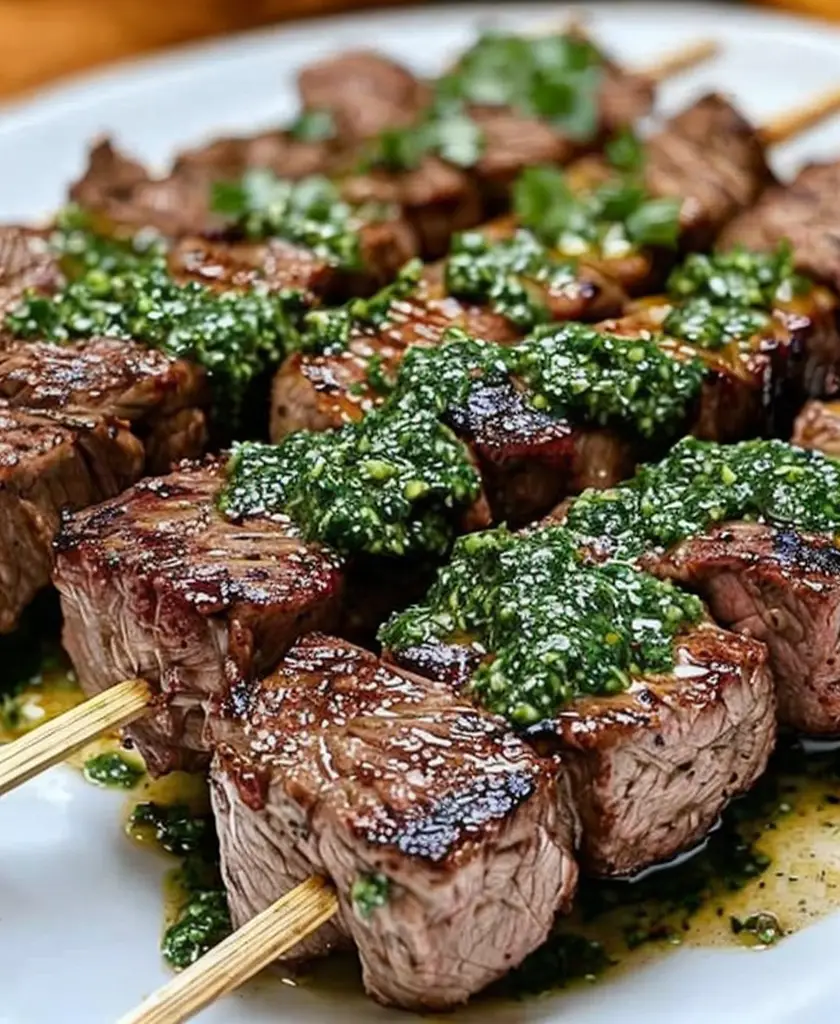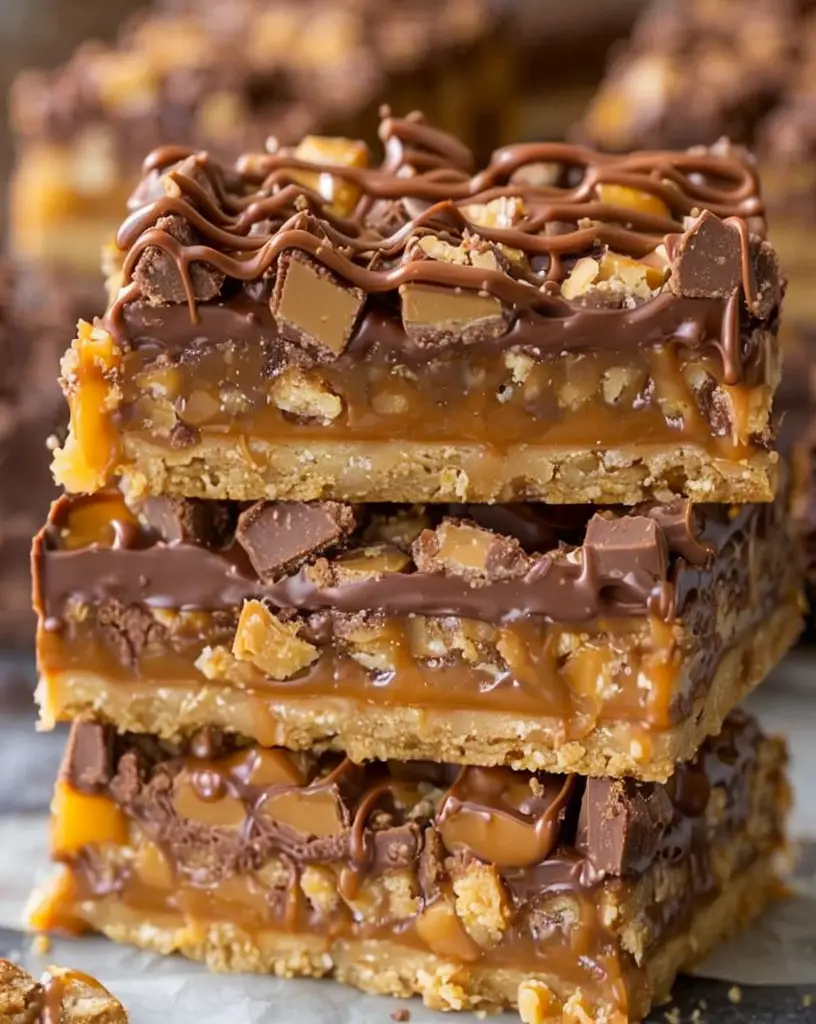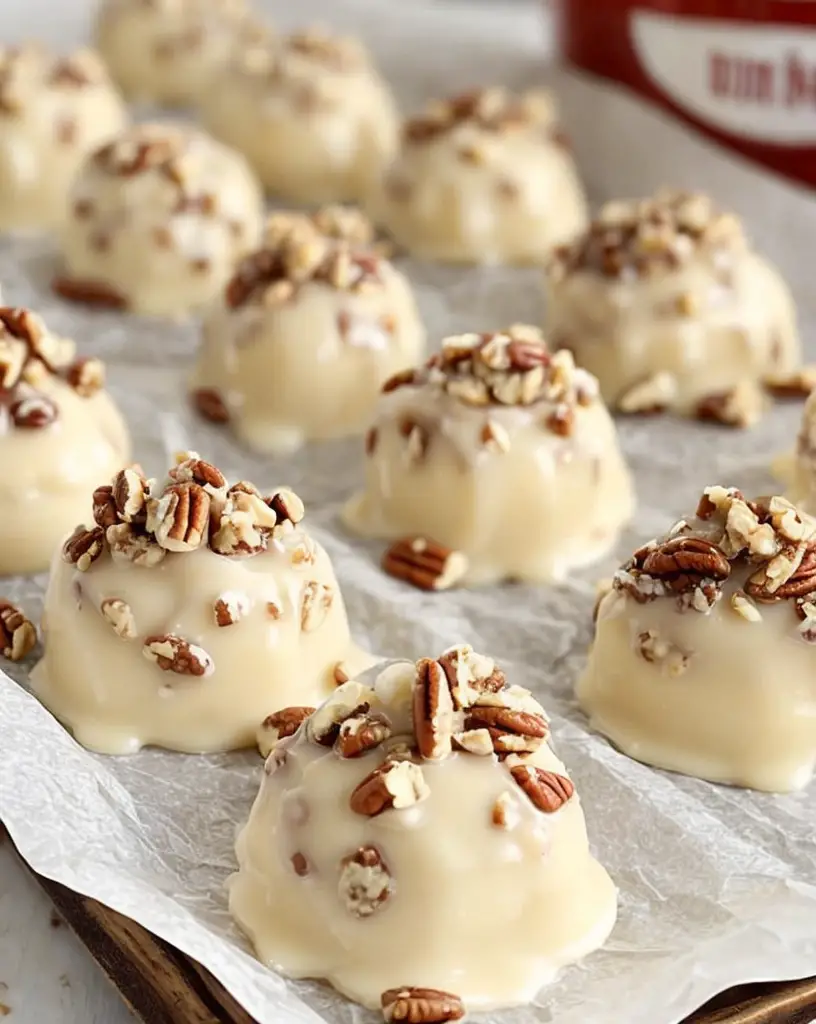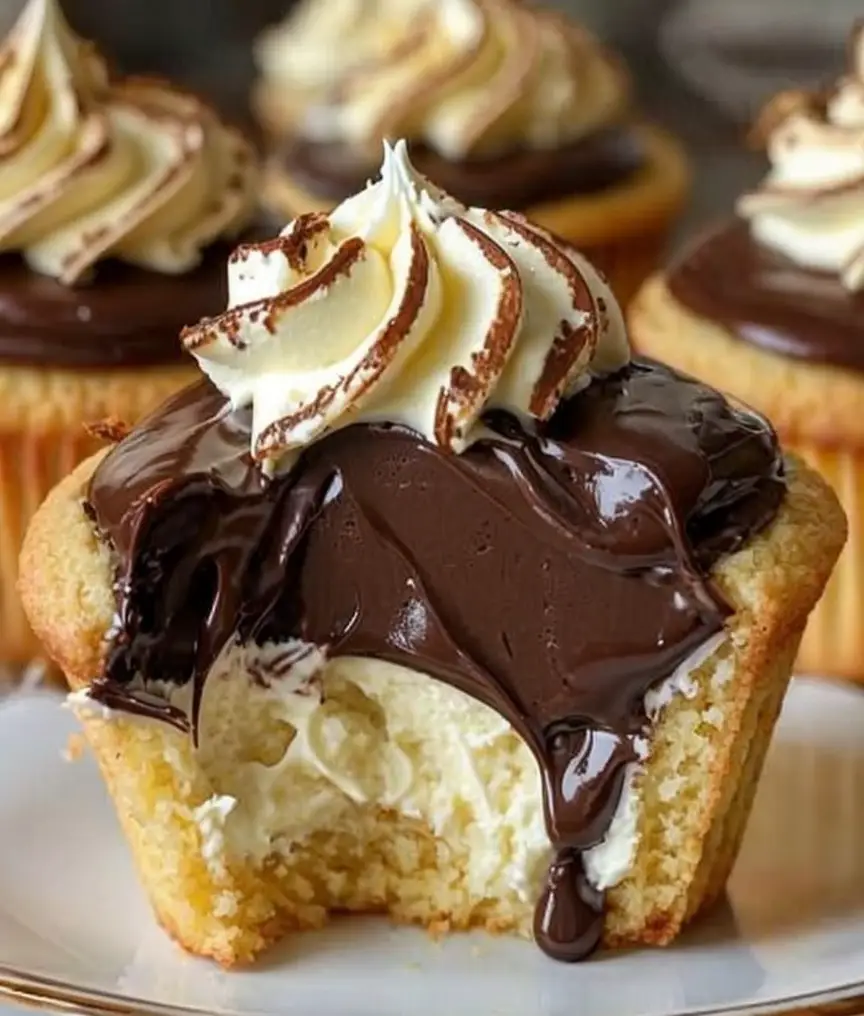Grilled Beef Skewers with Chimichurri Sauce: A Flavorful Summer Delight
Grilled beef skewers with chimichurri sauce are a delicious and satisfying dish perfect for summer gatherings or weeknight dinners. The tenderness of the marinated beef paired with the vibrant and herby chimichurri sauce creates an explosion of flavor that will impress your family and friends. These skewers are not only simple to prepare but also visually appealing, making them a great centerpiece for any outdoor feast.
The secret to these grilled beef skewers lies in the marinade and chimichurri sauce. The marinade ensures that the beef remains juicy and full of flavor while grilling enhances its natural richness. Meanwhile, the chimichurri, with its combination of fresh herbs, garlic, and olive oil, offers a bright and zesty contrast to the grilled meat, elevating the entire dish to gourmet levels.
Quick Recipe Highlights
- Flavor Profile: The skewers boast a smoky, savory flavor from the grilled beef and a refreshing, herbal kick from the chimichurri sauce.
- Texture: Perfectly charred beef offers a tender and juicy bite, while the chimichurri adds a lovely silkiness.
- Aroma: Expect an inviting aroma from the grilled meat, combined with the fragrant herbs and garlic in the chimichurri.
- Visual Appeal: Colorful skewers of beef accented by the bright green chimichurri make for an attractive presentation.
- Skill Level Needed: While the recipe is straightforward, some grilling technique is beneficial to avoid overcooking the meat.
- Special Equipment: A grill or grill pan, skewers, and a blender for the sauce are essential for this recipe.
Recipe Overview
- Difficulty Level: This recipe is categorized as medium difficulty due to the need for marinating and grilling but is achievable for home cooks with some experience.
- Category: These skewers can be classified under summer barbecues, appetizers, or main courses depending on the serving style.
- Cuisine: Originating from Argentina, chimichurri brings a South American flair to this dish that is beloved worldwide.
- Cost: The ingredients are relatively inexpensive, making this a budget-friendly option for gatherings.
- Season: Ideal for warm months when outdoor grilling is popular, but can also be enjoyed year-round.
- Occasion: Perfect for barbecues, picnics, family gatherings, or any casual dining experience.
Why You’ll Love This Recipe
The taste and texture of grilled beef skewers with chimichurri sauce are utterly irresistible. The charred exterior of the beef creates a depth of flavor that is so satisfying, complemented by the fresh and herbaceous notes of the chimichurri. Each bite delivers a delightful combination of savory meatiness and bright acidity, making it a dish you’ll crave again and again.
In terms of convenience, this recipe shines with its quick preparation and cooking time. The skewers can be prepped in advance and marinated for several hours or overnight, which allows the flavors to develop beautifully. When it’s time to cook, they grill up in less than 15 minutes, giving you more time to enjoy your day with friends and family.
From a nutritional standpoint, this dish is a great source of protein from the beef, while the chimichurri sauce introduces a wealth of vitamins and antioxidants thanks to its fresh herbs. The balance of nutrients makes this a wholesome choice for health-conscious diners.
The social aspect of grilling beef skewers cannot be understated. They are fun to cook and share, fostering a sense of community and excitement around the grill. This recipe easily serves a crowd, making it an excellent choice for parties and celebrations.
Cost-effectiveness is another significant reason to love this recipe. The ingredients are reasonably priced, and the yield provides ample servings, making it a fantastic option while keeping your budget in check.
Historical Background and Cultural Significance
Grilled beef skewers have their origins steeped in the rich culinary traditions of Argentina, where asado (barbecue) is a beloved cooking method. The culture of grilling meat over fire dates back to indigenous practices and has evolved among the country’s gauchos, or cowboys, who would grill beef over open flames.
Chimichurri, the traditional sauce that accompanies these skewers, adds a unique flavor that reflects Argentina’s diverse culinary influences. With roots in Spanish and Italian cuisine, this herb-based sauce has become an essential condiment in Argentinian meals, especially when paired with grilled meats.
As recipes have been passed down through generations, variations of grilled beef skewers have spread across Latin America and other regions. Each culture adapts the dish to its local flavors and ingredients, showcasing the global love for grilled meats.
Today, grilled beef skewers with chimichurri sauce represent not just a meal but a gathering around the grill, embodying communal sharing and celebration found in many cultures. They provide a perfect balance of flavors and a display of culinary skill that resonates with food lovers everywhere.
Ingredient Deep Dive
Beef:
Beef has been a staple in many cuisines worldwide; considered a source of nutrition and luxury. High in protein, beef contains essential amino acids necessary for muscle growth and repair. When selecting beef for skewers, look for cuts such as sirloin or flank steak for their tenderness and flavor. Proper storage at refrigerated temperatures is vital to maintaining freshness, and vacuum-sealed packages can extend shelf life. For those looking for variety, chicken or pork can be excellent substitutions in this recipe.
Chimichurri Ingredients (Parsley, Garlic, Olive Oil):
Fresh parsley is the cornerstone of chimichurri, bringing color and flavor. This herb is high in vitamins K and C, contributing to overall health. Incorporating garlic provides not only a pungent flavor but also many health benefits, including heart health and anti-inflammatory properties. The use of good-quality olive oil enhances the sauce’s richness and texture. When making chimichurri, ensure that the herbs are as fresh as possible for optimal flavor; store leftovers in an airtight container in the fridge.
Common Mistakes to Avoid
- Using tough cuts of meat: Always select tender cuts such as flank or sirloin for skewers to ensure a juicy bite.
- Overcrowding the skewers: Allow space between pieces to ensure even cooking and proper charring.
- Skipping the marinating step: Marinating the beef enhances flavor; don’t rush this step.
- Not preheating the grill: A hot grill is crucial for creating a good sear on the meat.
- Using dried herbs in chimichurri: Fresh herbs are key to achieving the bright flavor characteristic of real chimichurri.
- Overcooking the beef: Keep an eye on cooking times; aim for medium rare for better flavor and tenderness.
- Inconsistent skewer sizes or shapes: Cut uniform-sized beef pieces to ensure even cooking.
- Neglecting chimichurri seasoning adjustments: Taste your sauce and adjust the acidity or seasoning as needed before serving.
Essential Techniques
Marinating: This is an essential step in achieving flavorful skewers. To master marinating, ensure the meat is soaked in the marinade for an adequate time to allow flavors to penetrate. Keep in mind that different meats require varying marinating times; avoid marinating it for too long as it can affect texture. Look for changes in color and fragrance as cues that it’s ready to be grilled.
Grilling: Grilling beef skewers requires skill in heat management. Preheat the grill to high heat for a good sear and then adjust to medium heat for thorough cooking. Ensure to flip skewers frequently to prevent burning. Look for charred edges and a warm pink center as signs of perfectly grilled skewers.
Pro Tips for Perfect Grilled Beef Skewers
1. Soak wooden skewers in water for at least 30 minutes before grilling to prevent burning.
2. Ensure your grill is properly preheated to achieve a beautiful sear on the beef.
3. Don’t overcrowd the skewers; this ensures that each piece cooks evenly and gets charred effectively.
4. Use a meat thermometer to check for doneness; aim for 130°F for medium-rare to enjoy optimal tenderness.
5. Let the skewers rest for a few minutes after grilling; this allows the juices to redistribute, resulting in juicy meat.
6. Adjust chimichurri flavors based on personal preference—add more garlic or chili flakes for a bolder taste.
7. Experiment with different meats or vegetables on the skewers for a varied presentation and flavor profile.
8. Serve chimichurri on top of the skewers just before serving to keep the flavors fresh and vibrant.
Variations and Adaptations
Regional variations can be explored by using different marinades from various cuisines, such as teriyaki or Caribbean jerk. Seasonal adaptations might include adding seasonal vegetables like bell peppers, zucchini, or cherry tomatoes to your skewers for added flavor and nutrition. For dietary modifications, lean proteins like tofu or chicken can replace beef for a lighter version. If you prefer smoky flavors, consider using smoked paprika in your marinade.
For flavor variations, try adding citrus zest to the chimichurri for a fresh twist. Texture modifications can include adding crushed nuts for a slight crunch in the sauce. Play with presentation alternatives by serving skewers on a bed of grains, adding a colorful salad or garnishing with edible flowers.
Serving and Presentation Guide
For an elegant touch, consider using wooden boards for serving grilled beef skewers. You can create a rustic look by interspersing skewers with lemon wedges and fresh herbs. Garnishing with chopped parsley or microgreens adds both flavor and visual appeal. For a modern twist, serve skewers on a colorful plate drizzled with chimichurri for an eye-catching presentation.
Consider the serving temperature; skewers should be served hot off the grill for the best experience. To maintain the juiciness of the beef, serve with small portions accompanied by chimichurri for dipping or drizzling. This way, guests can enjoy the tenderness and flavor in every bite, contributing to overall meal success.
Wine and Beverage Pairing
Grilled beef skewers pair beautifully with red wines, such as Malbec or Cabernet Sauvignon, whose bold flavors complement the savory richness of the meat. For a lighter option, a crisp Pinot Noir or a fruity Zinfandel can work well.
Non-alcoholic alternatives could include iced tea or sparkling water with a twist of lemon or lime, which refreshes the palate between bites. Should you opt for coffee, a rich espresso can balance the meal nicely without overpowering the flavors.
Storage and Shelf Life
To store grilled beef skewers, place them in an airtight container in the refrigerator within two hours of cooking. They can be stored for up to three days. Ensure they’re properly cooled before sealing to prevent condensation. If you have leftover chimichurri, it can be kept in the refrigerator for up to a week.
For reheating, place skewers on a grill or in an oven until warmed through to maintain flavor and moisture. If you want to extend their shelf life, consider freezing the skewers. Wrap them tightly to prevent freezer burn and consume within three months for the best quality.
Make Ahead Strategies
For optimal flavor, marinate the beef skewers one day in advance and store them in the refrigerator. This allows all the spices and herbs to infuse deeply. Alternatively, you can also prepare the chimichurri sauce ahead of time and let it sit to enhance the flavors.
Assembling the skewers is a quick task, so aim to do it just before grilling for best results. If you’re hosting, consider having all grilling equipment and ingredients ready to go, making the cooking process smoother. You may choose to prepare additional fresh elements, like salads or side dishes, that can be made a day prior as well.
Scaling Instructions
Scaling this recipe up can be done easily by proportionally increasing the beef and marinade ingredients. For large gatherings, consider doubling or tripling the recipe, ensuring ample skewer space on the grill.
When halving the recipe, keep an eye on the grilling time as smaller quantities may cook faster. Adjust your equipment if necessary—use a larger grill for big batches to avoid overcrowding.
Ensure to maintain the same flavor intensity by monitoring your seasoning adjustments, as larger or smaller quantities can affect the balance of flavors in the marinade and chimichurri sauce.
Nutritional Deep Dive
Grilled beef skewers are a marvelous source of protein, fueling muscle repair and growth while providing essential amino acids. Each serving is rich in iron and zinc, important for energy and immune function. While beef may have higher fat content, choosing lean cuts can lower saturated fat intake.
Chimichurri contributes health benefits as well; packed with antioxidants from herbs and healthy fats from olive oil, it’s nutritious and heart-friendly. When planning portion sizes, aim for balanced meals with a variety of colors on your plate, promoting overall health.
Incorporating more vegetables into the skewers offers fiber, vitamins, and minerals, making it easier to meet dietary needs. Adjust servings based on individual dietary requirements while maintaining a fulfilling meal.
Dietary Adaptations
For gluten-free options, ensure all marinades and ingredients are certified gluten-free. To make the recipe dairy-free, simply avoid using dairy products in any accompaniment or side dish.
Vegetarians can enjoy a delicious meal by substituting beef with veggies such as mushrooms, bell peppers, or marinated tofu, which absorbs flavors beautifully. For dietary plans like Keto or Paleo, use protein alternatives in skewers, maintaining a focus on healthy fats and fresh vegetables.
Make sure to consider low-carb options by using alternative marinades that boost flavor without dependent on sugar. Choosing seasonally appropriate vegetables adds variety and keeps the recipe fresh and exciting throughout the year.
Troubleshooting Guide
Texture issues can arise if the meat is overcooked; always monitor grilling times closely and use a meat thermometer for accuracy. If the skewers are too dry, consider marinating for longer periods, enhancing both moisture and flavor.
Flavor balance is crucial; if skewers taste bland, double-check seasoning levels in both beef and sauce. If temperatures seem inconsistent, ensure even heat distribution on the grill, adjusting for hotspots accordingly.
Equipment challenges may include uneven grilling; if this happens, rotate skewers frequently for even cooking. For ingredient substitutions, make sure you’re aware of any flavor differences, adjusting seasoning in the final dish accordingly.
Timing concerns such as having cold or undercooked skewers can be rectified by letting them rest for a few minutes post-grilling, allowing heat to distribute evenly. Always ensure meat is cooked through for optimal safety.
Recipe Success Stories
Community feedback on grilled beef skewers with chimichurri sauce has been overwhelmingly positive, with many praising the flavor combinations and ease of preparation. Several home cooks have shared their experiences of adapting the recipe to suit personal preferences, such as adding spice or using different meats.
Readers have delighted in showcasing their own variations, using seasonal vegetables to apply a fresh touch. Photography tips provided by users often highlight vibrant colors and successful grilling techniques that capture the dish beautifully.
Stories of gatherings and barbecues utilizing this recipe have emerged, emphasizing the sense of connection and celebration that food brings, giving testament to the enduring popularity of grilled beef skewers with chimichurri.
Frequently Asked Questions
Can I use chicken instead of beef? Yes, chicken can be a great alternative; just ensure to adjust cooking times. Chicken should reach an internal temperature of 165°F.
How long should I marinate the beef? For optimal flavor, marinate the beef for 2-4 hours, but overnight is ideal to allow deeper penetration of flavors.
What can I serve with skewers? A fresh salad, rice, or grilled vegetables make great accompaniments, complementing the flavors of the beef and chimichurri.
Can I freeze the skewers? Yes, you can freeze them before cooking for up to three months; make sure to wrap them tightly to prevent freezer burn.
What if I don’t have a grill? A grill pan or broiler can work effectively to mimic grilling conditions, maintaining flavor and texture.
How do I know when the skewers are done? Use a meat thermometer to check for doneness; 130°F indicates medium-rare for beef skewers.
Can I make chimichurri sauce ahead of time? Absolutely; chimichurri can be made 1-2 days in advance and stored in the refrigerator.
Is chimichurri sauce spicy? Traditional chimichurri is not inherently spicy, but you can add chili flakes or jalapeños for heat if desired.
What if my chimichurri is too thick? Add a little more olive oil or vinegar to adjust the consistency to your liking.
How do I store leftovers? Store leftover skewers and chimichurri in airtight containers in the refrigerator for up to three days.
Additional Resources
Explore related recipes that feature rich and robust flavors, such as barbecue chicken or grilled vegetables. Additionally, consider guides on perfecting grilling techniques to enhance your overall cooking skills.
Information on selecting high-quality ingredients, particularly fresh herbs and vegetables, can elevate your dishes. Recommendations for essential grilling tools will ensure you are well-equipped for future culinary adventures. Finally, look into how seasonal variations can inspire new dishes that capture freshness and flavor effectively.
Join the Conversation
Sharing your grilling experiences and successes with the community is encouraged! Post photos of your skewers, and don’t hesitate to exchange tips and recipe variations. Reader feedback is invaluable, contributing to the continuous evolution of flavorful dishes.
Consider engaging on social media platforms by reviewing the recipe and sharing your unique adaptations. Your culinary experiences and photography can inspire others, making the world of cooking a vibrant community of skilled food enthusiasts.
The Recipe
Grilled Beef Skewers with Chimichurri Sauce
Serves: 4
Prep Time: 15 mins
Cook Time: 10 mins
Total Time: 25 mins
Kitchen Equipment Needed
- Grill or Grill Pan
- Skewers (metal or soaked wooden)
- Mixing Bowl
- Blender or Food Processor for Chimichurri
Ingredients
- 1 lb beef sirloin, cut into 1-inch cubes
- 2 tbsp olive oil
- 2 cloves garlic, minced
- 1 tsp salt
- 1 tsp black pepper
- 1 tbsp balsamic vinegar
- 1 cup fresh parsley, chopped
- 1/2 cup olive oil (for chimichurri)
- 2 cloves garlic, minced (for chimichurri)
- 1/4 cup red wine vinegar
- 1/2 tsp red pepper flakes (optional)
Directions
- In a mixing bowl, combine olive oil, minced garlic, salt, pepper, and balsamic vinegar. Add beef cubes, ensuring they’re well coated. Allow to marinate for 2-4 hours in the refrigerator.
- While beef marinates, prepare chimichurri by blending parsley, olive oil, garlic, red wine vinegar, and red pepper flakes until smooth. Adjust seasoning as needed.
- Preheat the grill over medium-high heat. Thread marinated beef onto skewers, leaving space between pieces.
- Grill skewers for 8-10 minutes, turning occasionally until desired doneness is reached.
- Remove from grill and let rest for a few minutes. Serve drizzled with chimichurri sauce.
Recipe Notes
- For extra flavor, add vegetables like bell peppers or mushrooms to the skewers.
- Adjust the heat of chimichurri by increasing or decreasing the red pepper flakes.
- Make extra chimichurri for dipping or drizzling on other grilled meats and vegetables.




